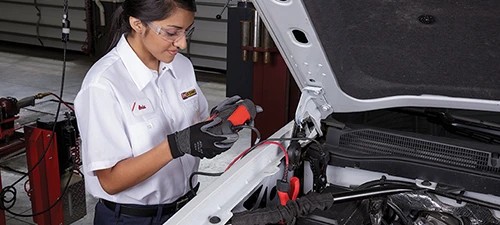Few things are more frustrating than turning the key in your ignition or pressing the start button and being met with silence. A car that won’t start can disrupt your entire day, leaving you stranded and wondering what went wrong. While there could be various reasons behind this issue, the most common culprits often revolve around problems with your car’s battery or alternator. Understanding the signs and symptoms of each can help you diagnose the problem and take appropriate action.
Decoding the Silence: Is It Your Battery?
A car battery is the heart of your vehicle’s electrical system when it comes to starting. It provides the initial jolt of power needed to crank the engine. When your car struggles to start, or refuses to start at all, a failing battery is often the first suspect. Here are key indicators that your battery might be the reason why your car isn’t starting:
Recognizing the Symptoms of a Weak or Dead Battery
- Dim Lights: Noticeably dimmer dashboard lights and interior lights when you turn the key to the “on” position is a classic sign of a weak battery.
- Slow Electrical Functions: If your windshield wipers move sluggishly, or your electric windows struggle to open or close, it points to insufficient power from the battery.
- Corrosion on Battery Terminals: Visible white, powdery buildup on the battery terminals (the metal posts where cables connect) indicates corrosion, which can impede electrical flow.
- Radio Silence: If the radio fails to turn on at all when you try to start the car, the battery may not be providing enough power.
- Swollen Battery Case: In extreme cases, a battery that is failing internally can swell or bulge. This is a sign of a serious battery issue and potential hazard.
- Sluggish Engine Cranking: When you turn the key, does the engine crank slowly and weakly, almost like it’s struggling to turn over? This “sluggish cranking” is a strong indicator of a battery problem.
- No Sound or Lights: In the most severe cases of battery failure, you might experience complete silence when you try to start the car – no engine cranking, no lights, nothing.
- Inconsistent Starting: Does your car start sometimes, but not others? Intermittent starting issues can be a sign of a battery that is nearing the end of its life.
- Starts with a Jump, Fails Afterward: If your car starts easily with jumper cables from another vehicle, but then fails to restart on its own after being turned off, it strongly suggests a battery problem.
Confirming Your Battery is the Issue
If you observe several of these symptoms, especially after your battery has been in service for more than three to five years, it’s highly likely that your battery is the source of your starting woes. Jump-starting your car successfully is another strong clue pointing to the battery. However, keep in mind that a jump start is only a temporary fix and doesn’t address the underlying problem if your battery is indeed failing. For a definitive diagnosis, a professional battery test is recommended.
Alternator Trouble: Keeping the Engine Running
The alternator is a component that often gets confused with the battery, but it plays a different, yet equally vital role. Once your car is started, the alternator takes over, generating power to run your vehicle’s electrical systems and, crucially, to recharge the battery while you drive. If the alternator fails, your battery won’t get recharged, and eventually, your car will likely stall or fail to start again.
Recognizing the Symptoms of a Failing Alternator
- Difficulty Starting (Initially): While a dead battery is a more common cause of starting problems, a failing alternator can sometimes contribute to hard starts, especially if it has been gradually weakening and not properly charging the battery.
- Frequent Stalling: A key symptom of alternator trouble is your car stalling shortly after starting, or even while driving. This happens because the alternator isn’t providing power, and the car is running solely off the battery’s charge, which quickly depletes.
- Squealing Noises from the Engine: A worn-out alternator belt or failing alternator bearings can produce a noticeable squealing or whining sound, especially when electrical load increases (like turning on the heater or radio). The sound may change with engine RPM.
- Dimming and Brightening Lights: Fluctuating headlight and interior light intensity – dimming and then suddenly brightening – is a classic sign of an inconsistent power supply from a failing alternator.
- Check Engine Light or Battery Warning Light: The “Check Engine” light or a dedicated battery-shaped warning light on your dashboard might illuminate if the alternator isn’t charging correctly. These lights can signal various issues, so it’s important to have the car scanned for codes to confirm the cause.
- Car Dies Immediately After Jump Start: If your car starts with a jump, but then dies almost immediately after disconnecting the jumper cables, it’s a strong indicator of alternator failure. The alternator isn’t able to sustain the electrical system once the jump start power is removed.
A Simple Alternator Test
While specialized tools are needed for precise alternator testing, a rudimentary check you can perform involves starting your car (if possible) and then turning on the radio to an AM station at the lower end of the dial. Rev the engine. If you hear a noticeable whine or static that changes in pitch or intensity as you rev, it could suggest alternator noise interfering with the radio signal, potentially indicating alternator issues.
Driving with a Suspect Battery or Alternator: Proceed with Caution
Driving with a known bad battery is risky because you could easily get stranded the next time you turn off the engine. A failing alternator is even more concerning. It can lead to sudden stalling while driving, which can be dangerous, especially in heavy traffic or at high speeds. Furthermore, relying solely on battery power due to a bad alternator can damage other electrical components in your car.
It’s always best to address suspected battery or alternator problems promptly.
The Roles of the Battery and Alternator: A Quick Recap
To summarize, the car battery provides the initial electrical energy to start the engine. Once the engine is running, the alternator takes over, recharging the battery and powering the car’s electrical systems. They work in tandem to ensure your car starts reliably and runs smoothly.
When in Doubt, Seek Professional Help
Diagnosing car starting problems can sometimes be tricky, as symptoms can overlap between battery and alternator issues, and other components like the starter motor or ignition system could also be involved. If you’re unsure why your car isn’t starting, or if you suspect a battery or alternator problem, it’s always wise to consult a qualified mechanic. They have the expertise and diagnostic tools to accurately pinpoint the cause of the issue and recommend the necessary repairs, ensuring you’re back on the road safely and reliably. Regular car maintenance, including battery checks, can also help prevent unexpected starting problems and extend the life of your car’s electrical system.

